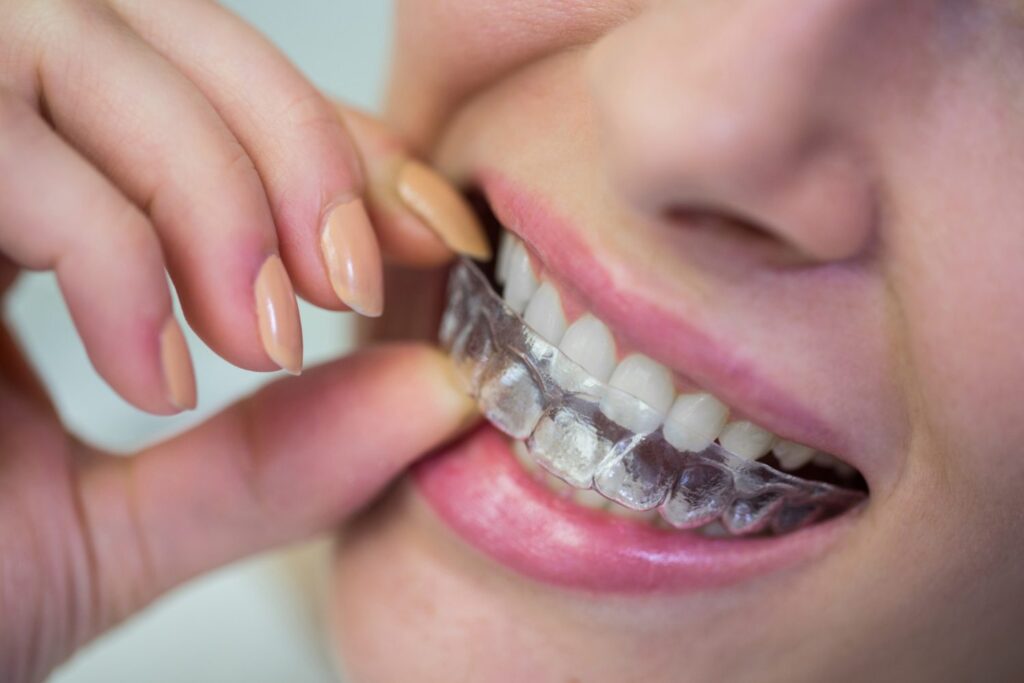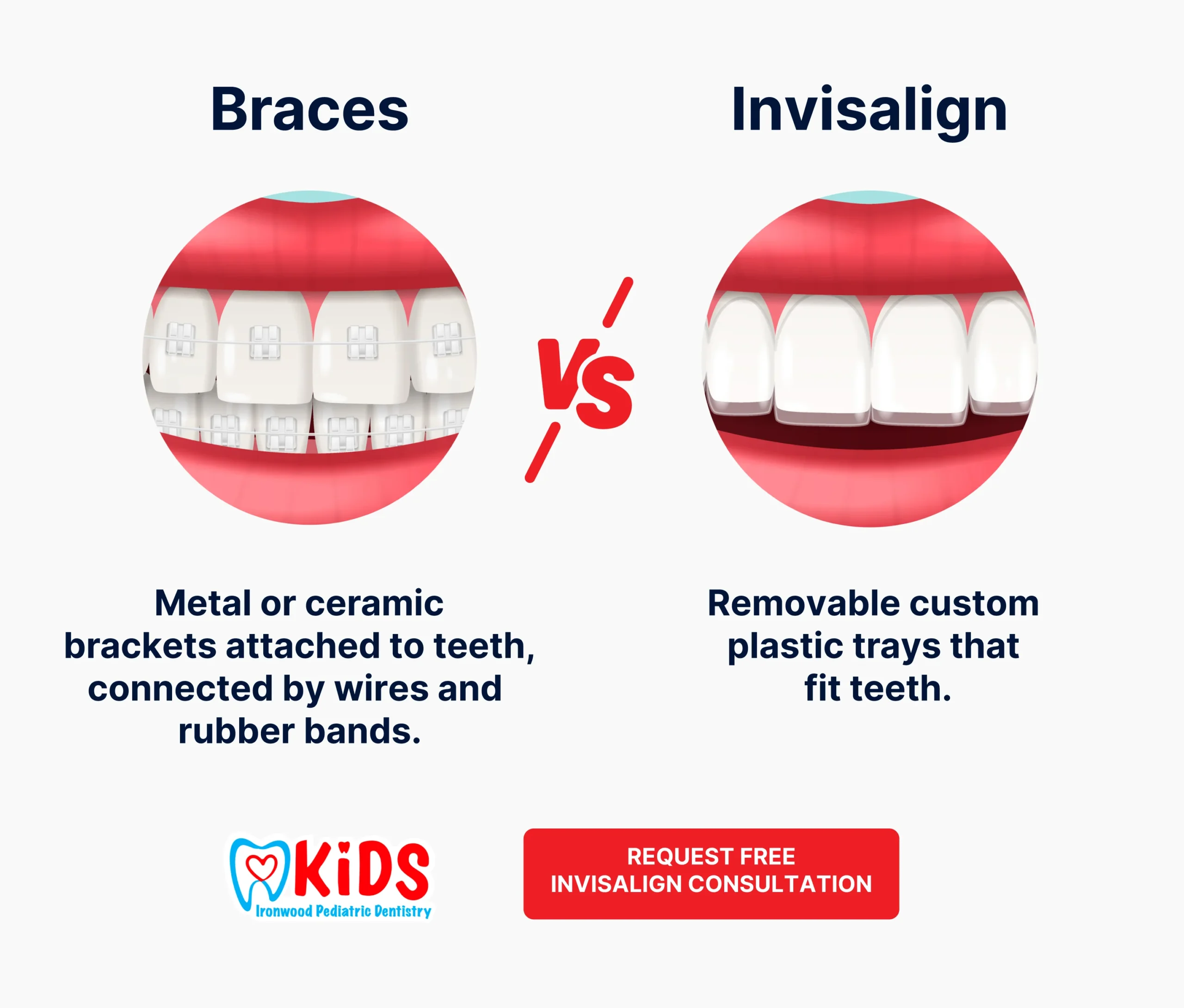Frequently Asked Questions Regarding Invisalign: Everything You Need to Know
Frequently Asked Questions Regarding Invisalign: Everything You Need to Know
Blog Article
Invisalign vs. Traditional Braces: Which Choice Is Right for You?
When considering orthodontic treatment, the selection in between Invisalign and standard dental braces provides several important variables that warrant cautious assessment. Invisalign offers a very discreet choice with detachable aligners, while conventional braces give a much more visible yet reliable remedy for serious misalignment.
Review of Treatment Alternatives

In contrast, standard dental braces include steel braces and wires that are bound to the teeth. This approach applies constant stress over time to accomplish placement. While effective for complicated orthodontic concerns, traditional braces need normal check outs for changes and can pose challenges in preserving dental health due to the difficulty of cleaning up about wires and brackets.
Both choices have their values, and the choice frequently hinges on certain oral problems, way of living preferences, and client compliance. Eventually, getting in touch with an orthodontic professional is essential for identifying one of the most suitable treatment plan tailored to individual needs. Understanding the nuances of each choice can substantially affect the general success of orthodontic therapy.
Aesthetic Considerations
A considerable element influencing the choice between Invisalign and traditional braces is the visual allure each therapy uses. Invisalign aligners are crafted from clear plastic, making them essentially undetectable when used. This discreet look is specifically interesting teenagers and grownups that may feel self-conscious regarding their orthodontic therapy. The capability to maintain an all-natural smile throughout the placement procedure can considerably enhance the person's self-confidence in social and expert setups.
On the other hand, typical braces contain metal brackets and cables, which can be more recognizable. While improvements in orthodontic technology have actually resulted in the growth of smaller braces and colored elastics, typical braces still keep a more noticeable account. For some individuals, the presence of braces might discourage them from looking for required therapy.
Ultimately, the selection between Invisalign and standard dental braces may rest on individual preferences pertaining to appearances. Clients that focus on discretion commonly lean toward Invisalign, while those who are much less concerned regarding presence may choose typical braces. Recognizing the visual implications of each choice is important for making an educated choice that straightens with one's lifestyle and preferences.
Comfort and Convenience

In terms of ease, Invisalign aligners are removable, making it possible for individuals to enjoy their favored foods without restriction and preserve ideal oral health. Brushing and flossing are streamlined, as the aligners can be taken out during these routines, whereas conventional dental braces require mindful maneuvering around braces and wires.
Additionally, Invisalign's modern system enables less orthodontic visits. Patients generally receive several sets of aligners at the same time, which can improve the treatment process and decrease time spent in the orthodontist's chair. On the other hand, conventional braces demand normal adjustments, making them less convenient for those with busy timetables. Invisalign. Generally, the comfort and convenience of Invisalign make it an enticing choice for lots of people looking for orthodontic treatment.
Treatment Duration and Effectiveness
While both Invisalign and standard braces work in fixing dental imbalances, the period of therapy can differ significantly between the 2 choices. Usually, Invisalign treatment can take anywhere from 12 to 18 months, depending upon the complexity of the case. The clear aligners function by gradually moving teeth right into their preferred settings, and routine follow-ups with an orthodontist help make certain progress remains on track.
In contrast, conventional braces often call for a longer commitment, typically varying from moved here 18 months to three years. This results from their fixed nature and the use of brackets and cords, which can be extra reliable for severe misalignments and intricate cases (Invisalign). The therapy performance of conventional braces is well-documented, as they permit exact modifications and better control over tooth activity
Inevitably, the choice between Invisalign and conventional dental braces might rest on both the anticipated therapy duration and the particular oral concerns at hand. Consulting with an orthodontist is essential, as they can provide customized referrals based upon specific requirements, ensuring the picked technique lines up with preferred durations and end results.
Cost Contrast and Insurance Choices
Expense plays a substantial role in the decision-making process for individuals considering orthodontic therapy, whether selecting Invisalign or standard dental braces. Typically, the expense of Invisalign varieties from $3,000 to $8,000, while typical dental braces generally cost in between $2,000 and $6,000. Variables affecting these expenses consist of the intricacy of the case, the duration of therapy, and geographical area.
Insurance policy insurance coverage can considerably affect out-of-pocket costs. Many dental insurance coverage strategies supply partial coverage for orthodontic therapies, however the specifics can vary extensively. It is critical for clients to evaluate their insurance coverage to determine the level of coverage for either option. Generally, typical dental braces might be a lot more frequently covered by insurance policy plans contrasted to Invisalign, which some insurance companies classify as an aesthetic treatment.
Additionally, numerous orthodontic practices supply versatile settlement strategies, making both treatment alternatives a lot more available. People should ask about possible funding options helpful site and discounts for in advance repayments. Reviewing the complete price, including insurance policy benefits and layaway plan, is necessary for making an educated choice that aligns with both aesthetic preferences and budget considerations.

Conclusion
In recap, the choice between Invisalign and conventional dental braces pivots on numerous factors, consisting of aesthetic choices, comfort, therapy duration, and price. Invisalign provides a very discreet, removable choice that assists in dental hygiene and dietary flexibility, while conventional dental braces might be a lot more suitable for complex oral concerns and typically come at a reduced cost factor. Inevitably, consultation with an orthodontist is important to evaluate individual situations and identify one of the most ideal therapy choice for accomplishing optimum dental placement.
When considering orthodontic treatment, the choice between Invisalign and conventional braces presents a number of essential factors that warrant mindful analysis.Comparing Invisalign and typical dental braces exposes distinct treatment choices his comment is here for orthodontic modification.While both Invisalign and typical braces are effective in correcting dental misalignments, the duration of treatment can vary substantially in between the two choices.Cost plays a substantial duty in the decision-making procedure for people taking into consideration orthodontic treatment, whether deciding for Invisalign or standard dental braces.In summary, the selection between Invisalign and traditional dental braces hinges on several variables, including aesthetic choices, convenience, treatment period, and price.
Report this page